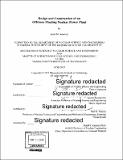Design and construction of an offshore floating nuclear power plant
Author(s)
Jurewicz, Jacob M
DownloadFull printable version (21.42Mb)
Alternative title
Offshore floating nuclear power plant
OFNP
Other Contributors
Massachusetts Institute of Technology. Department of Nuclear Science and Engineering.
Advisor
Jacopo Buongiorno.
Terms of use
Metadata
Show full item recordAbstract
This thesis details the ongoing development of a new Offshore Floating Nuclear Plant (OFNP) concept that exhibits a promising potential for economic and rapid deployment on a global scale. The OFNP creatively combines state-of-the-art Light Water Reactors (LWRs) and floating platforms similar to those used in offshore oil and gas operations. A reliable and cost-effective global supply chain exists for both technologies, which enables a robust expansion in the use of nuclear energy on a time scale consistent with combating climate change in the near future. The OFNP is a plant that can be entirely built within a floating platform in a shipyard, transferred to the site, where it is anchored within 12 nautical miles (22 km) off the coast in relatively deep water (=/> 100 m), and connected to the grid via submarine AC transmission cables. Shipyard construction ensures a supply of qualified workers and facilities, and it brings mass-production-like construction efficiency to existing reactor designs. Eventual shipyard decommissioning allows sites to immediately return to a "green field" condition when the plant's life is spent. The crews would operate in monthly or semi-monthly shifts with onboard living quarters, similar to oil and gas platforms. The OFNP is a nuclear plant specifically designed for the global market: it can be constructed in one country or multiple countries and exported internationally. It lends itself to a flexible and mobile electricity generation strategy, which minimizes the need for indigenous nuclear infrastructure in the host country and does not commit the customer to a 40 to 60 years-long project.
Description
Thesis: S.M. and S.B., Massachusetts Institute of Technology, Department of Nuclear Science and Engineering, 2015. Cataloged from PDF version of thesis. Includes bibliographical references (pages 135-138).
Date issued
2015Department
Massachusetts Institute of Technology. Department of Nuclear Science and EngineeringPublisher
Massachusetts Institute of Technology
Keywords
Nuclear Science and Engineering.